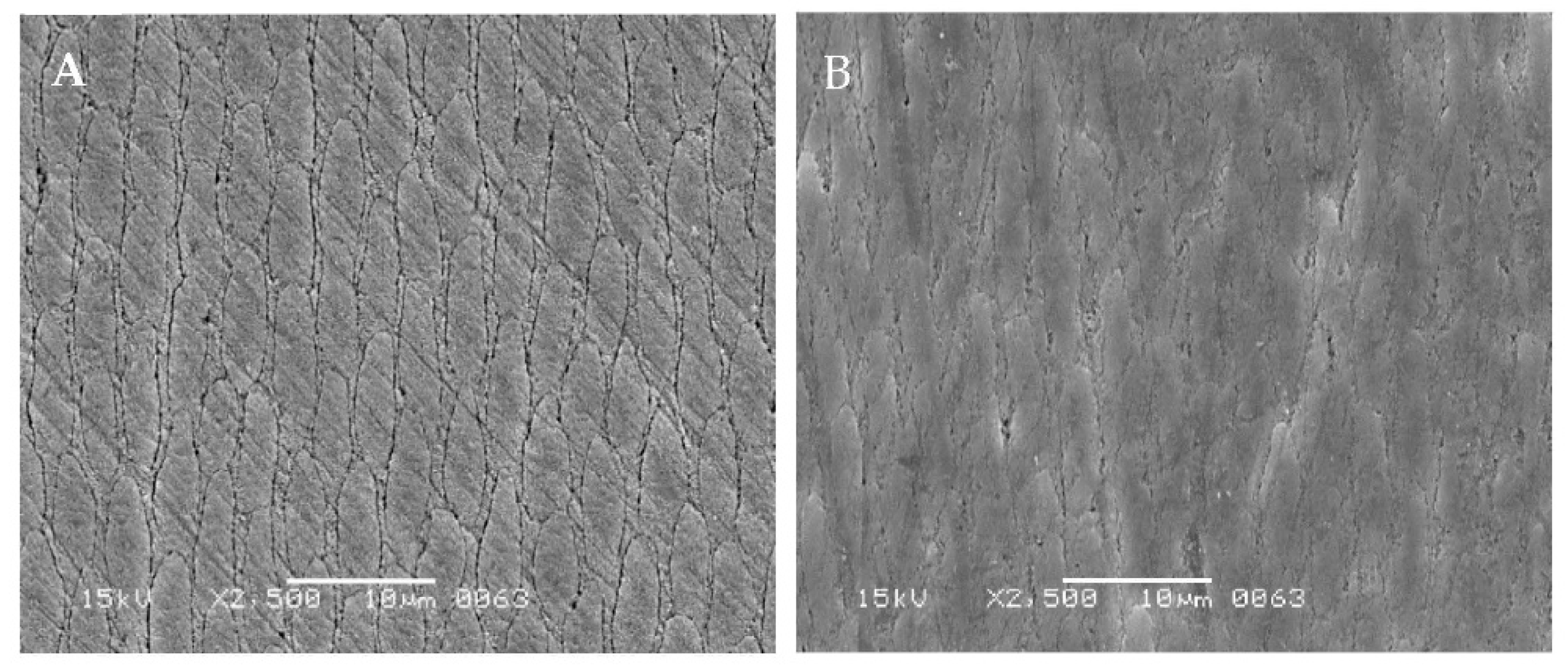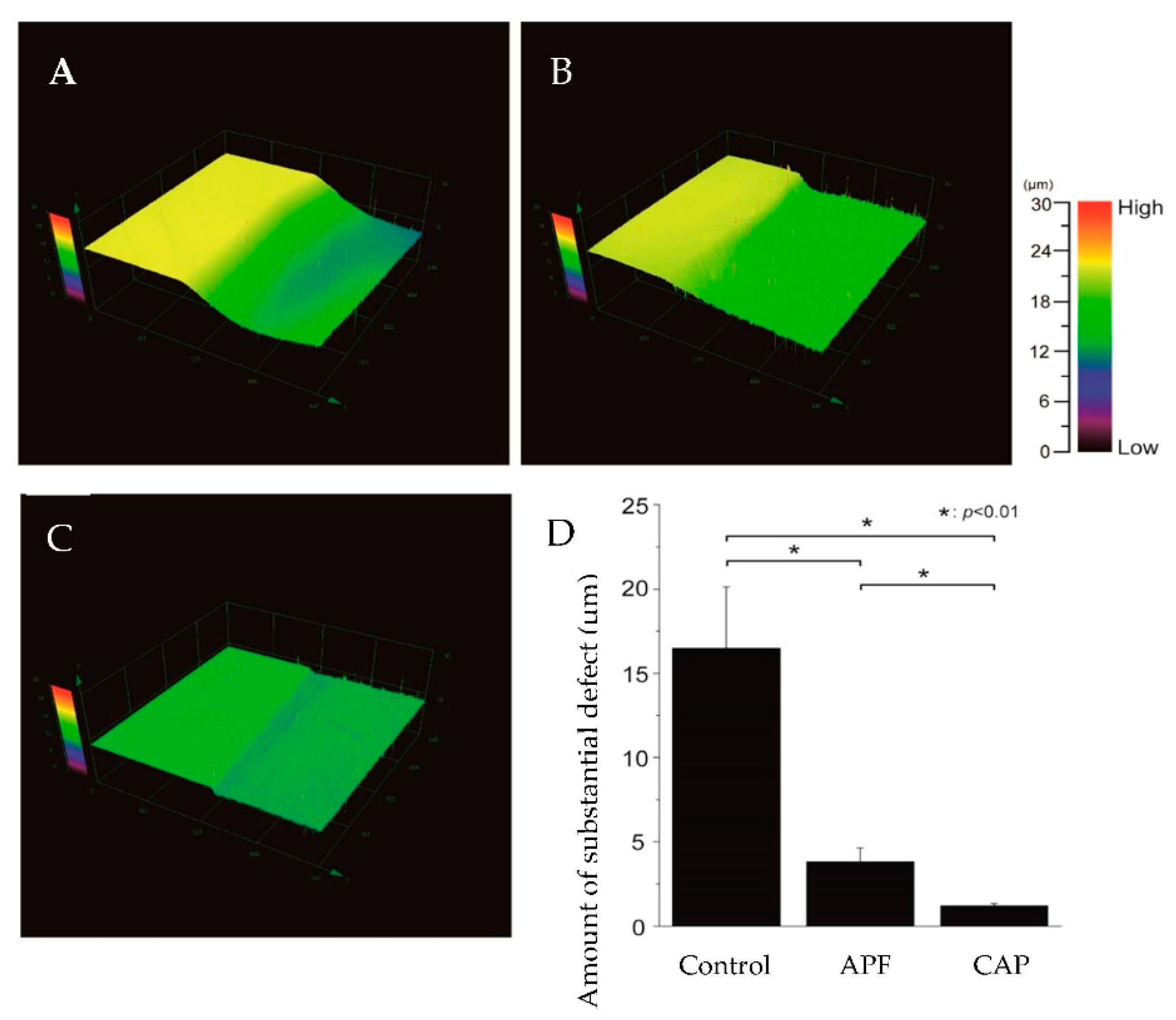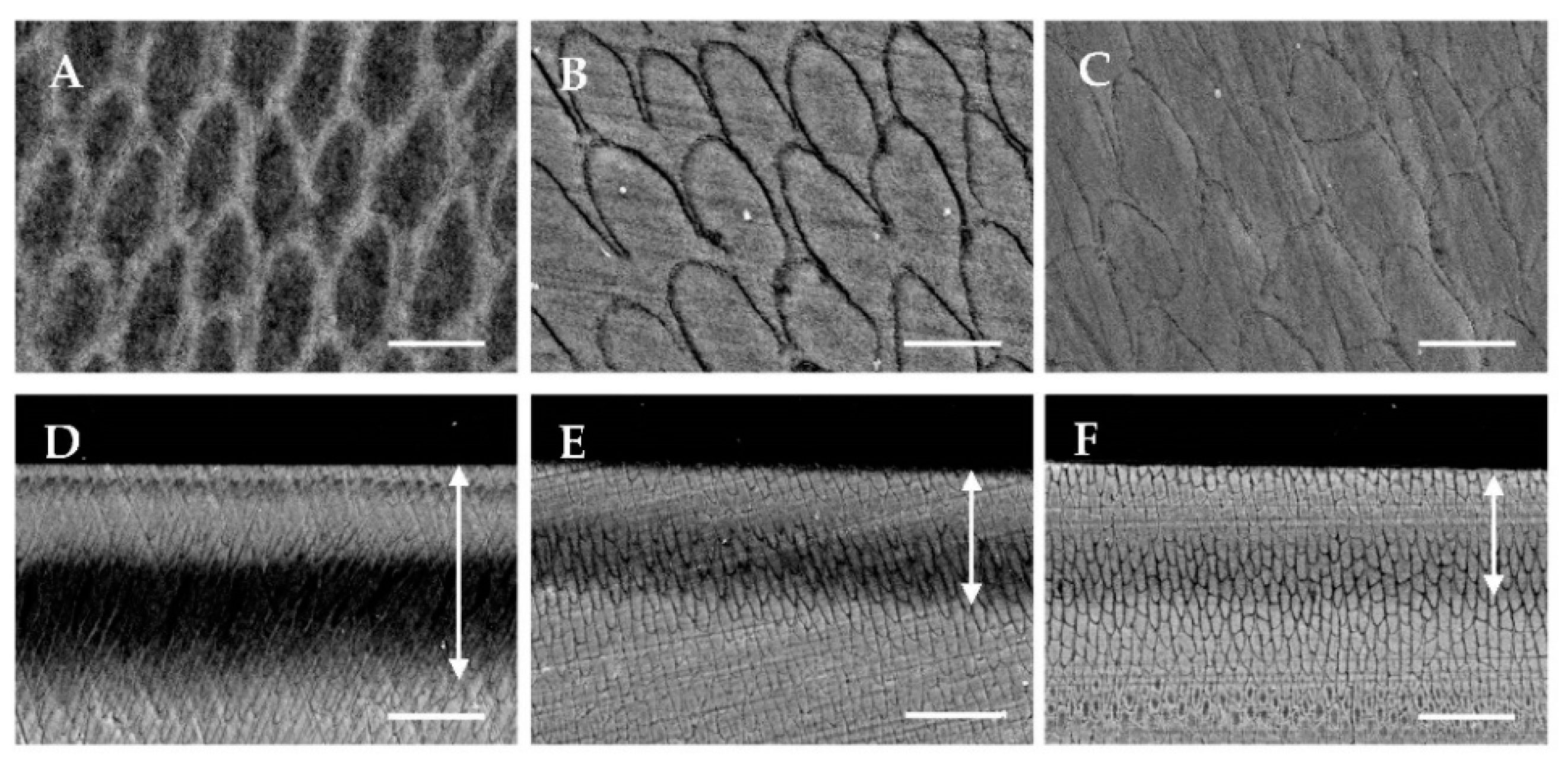Evaluation of Enamel Acid Resistance and Whitening Effect of the CAP System
Abstract
:1. Introduction
2. Materials and Methods
2.1. Preparation of Enamel Samples
2.2. Reagents
- Calcium phosphate (a-powder): α-TCP, φ8–15 μm (Taihei Chemical Industrial Co. Ltd., Osaka, Japan);
- Citric acid gel (C-gel): 5% citric acid, 0.01% malic acid, 5% glycerin, 3% tamarind gum, others (pH 3.0) (AIWA Co. Ltd. Osaka, Japan);
- Fluoride gel (APF, Fluor Jelly®): 2% NaF, (pH 3.5) (Bee Brand Medico Dental Co. Ltd., Osaka, Japan);
- Gel for neutralization (CR-gel): 1.0% Na5P3O10, 0.01% NaOH, 10% glycerin, 1.5% xanthan gum, 1.0% cellulose gum, others (pH 9.3) (AIWA, Co. Ltd. Osaka, Japan);
- Remineralization solution (for acid challenge experiment): 0.02M HEPES (Ca: 3 mM, P: 1.8 mM, pH adjustment to 7.3 using KOH);
- Demineralization solution (for acid challenge experiment): 0.1-M lactate buffer solution (2.5% hydroxyethyl cellulose) (Ca: 3 mM, P: 1.8 mM, pH adjustment: KOH; pH 4.5).
2.3. Acid Resistance Strengthening of Teeth
- C-gel application for 30 s;
- Wipe with melamine foam;
- Application of a-powder and C-gel mixture for 1 min (weight ratio 1:2);
- Application of Fluor Jelly® for 3 min;
- Wipe with melamine foam;
- Application of CR-gel for 1 min;
- Washing with water.
2.4. Acid Challenge Experiment
2.5. Measurement of Height Difference Profiles
2.6. Micro Vickers Hardness Measurement
2.7. Scanning Electron Microscopy (SEM)
2.8. Whitening Effect Experiment
2.9. Statistical Processing
3. Results
3.1. Observation of Enamel Surface
3.2. Height Difference Profiles
3.3. Micro Vickers Hardness Measurement
3.4. SEM after Acid Challenge
3.5. Whitening Effect Experiment
4. Discussion
5. Conclusions
Author Contributions
Funding
Institutional Review Board Statement
Informed Consent Statement
Data Availability Statement
Acknowledgments
Conflicts of Interest
References
- Whelton, H.P.; Spencer, A.J.; Do, L.G.; Rugg-Gunn, A.J. Fluoride revolution and dental caries: Evolution of policies for global use. J. Dent. Res. 2019, 98, 837–846. [Google Scholar] [CrossRef] [PubMed]
- Ten Cate, J.M.; Duijsters, P.P.E. Influence of fluoride in solution on tooth demineralization. II. Microradiographical data. Caries Res. 1983, 17, 513–519. [Google Scholar] [CrossRef] [PubMed]
- Suge, T.; Kawasaki, A.; Ishikawa, K.; Matsuo, T.; Ebisu, S. Effects of calcium phosphate precipitation method on acid resistance to apatite powder and bovine tooth. Dent. Mater. J. 2008, 27, 508–514. [Google Scholar] [CrossRef] [PubMed]
- Elembaby, A.; AlHumaid, J.; El Tantawi, M.; Akhtar, S. The impact of nano-hydroxyapatite resin infiltrant on enamel remineralization: An in vitro study. Int. J. Periodontics Restor. Dent. 2022, 42, e43–e50. [Google Scholar] [CrossRef]
- O’Hagan-Wong, K.; Enax, J.; Meyer, F.; Ganss, B. The use of hydroxyapatite toothpaste to prevent dental caries. Odontology 2022, 110, 223–230. [Google Scholar] [CrossRef] [PubMed]
- Zhou, L.; Wong, H.M.; Zhang, Y.Y.; Li, Q.L. Constructing an antibiofouling and mineralizing bioactive tooth surface to protect against decay and promote self-healing. ACS Appl. Mater. Interfaces 2020, 12, 3021–3031. [Google Scholar] [CrossRef]
- Ogard, B.; Seppä, L.; Rølla, G. Professional topical fluoride applications--clinical efficacy and mechanism of action. Adv. Dent. Res. 1994, 8, 190–201. [Google Scholar] [CrossRef]
- Lippert, F.; Butler, A.; Lynch, R.J.M.; Hara, A.T. Effect of fluoride, lesion baseline severity and mineral distribution on lesion progression. Caries Res. 2012, 46, 23–30. [Google Scholar] [CrossRef]
- Nakahira, A.; Sakamoto, K.; Yamaguchi, S.; Kijima, K.; Okazaki, M. Synthesis of hydroxyapatite by hydrolysis of α-TCP. J. Ceram. Soc. Jpn. 1999, 107, 89–91. [Google Scholar] [CrossRef]
- Driessens, F.C.M.; Planell, J.A.; Boltong, M.G.; Khairoun, I.; Ginebra, M.P. Osteotransductive bone cements. Proc. Inst. Mech. Eng. 1998, 212, 427–435. [Google Scholar] [CrossRef]
- Boskey, A.L.; Posner, A.S. Conversion of amorphous calcium phosphate to microcrystalline hydroxyapatite. A pH-dependent, solution-mediated, solid-solid conversion. J. Phys. Chem. 1973, 77, 2313–2317. [Google Scholar] [CrossRef]
- Varughese, k.; Moreno, E.C. Crystal growth of calcium apatites in dilute solutions containing fluoride. Calcif. Tissue Int. 1981, 33, 431–439. [Google Scholar] [CrossRef] [PubMed]
- Shimoda, S.; Aoba, T.; Moreno, E.C.; Miake, Y. Effect of Solution Composition on Morphological and Structural Features of Carbonated Calcium Apatites. J. Dent. Res. 1990, 69, 1731–1740. [Google Scholar] [CrossRef]
- Soares, L.E.S.; da Silva Magalhães, J.; Marciano, F.R.; Lobo, A.O. Surface characteristics of a modified acidulated phosphate fluoride gel with nano-hydroxyapatite coating applied on bovine enamel subjected to an erosive environment. Microsc. Res. Tech. 2018, 81, 1456–1466. [Google Scholar] [CrossRef]
- Demito, C.F.; da Costa, J.V.; Fracasso, M.L.C.; Ramos, A.L. Efficacy of fluoride associated with nano-hydroxyapatite in reducing enamel demineralization adjacent to orthodontic brackets: In situ study. Dent. Press J. Orthod. 2019, 24, 48–55. [Google Scholar] [CrossRef]
- Oliveira, M.R.C.; Oliveira, P.H.C.; Oliveira, L.H.C.; Horliana, A.C.R.T.; César, P.F.; Moura, S.K.; Bussadori, S.K. Microhardness of bovine enamel after different fluoride application protocols. Dent. Mater. J. 2019, 38, 61–67. [Google Scholar] [CrossRef] [PubMed]
- Soveral, M.; Machado, V.; Botelho, J.; Mendes, J.J.; Manso, C. Effect of resin infiltration on enamel: A systematic review and meta-analysis. J. Funct. Biomater. 2021, 12, 48. [Google Scholar] [CrossRef]
- Attin, T.; Schmidlin, P.R.; Wegehaupt, F.; Wiegand, A. Influence of study design on the impact of bleaching agents on dental enamel microhardness: A review. Dent. Mater. Off. Publ. Acad. Dent. Mater. 2009, 25, 143–157. [Google Scholar] [CrossRef]
- Juntavee, N.; Juntavee, A.; Plongniras, P. Effectiveness of nanohydroxyapatite on demineralization of enamel and cementum surrounding margin of yttria-stabilized zirconia polycrystalline ceramic restoration. Sci. World J. 2021, 2021, 5540738. [Google Scholar] [CrossRef]
- Huang, S.; Gao, S.; Cheng, L.; Yu, H. Remineralization potential of nano-hydroxyapatite on initial enamel lesions: An in vitro study. Caries Res. 2011, 45, 460–468. [Google Scholar] [CrossRef]
- Huang, S.B.; Gao, S.S.; Yu, H.Y. Effect of Nano-hydroxyapatite concentration on remineralization of initial enamel lesion in vitro. Biomed. Mater. Bristol Engl. 2009, 4, 034104. [Google Scholar] [CrossRef] [PubMed]
- Huang, S.; Gao, S.; Cheng, L.; Yu, H. Combined effects of nano-hydroxyapatite and Galla chinensis on remineralisation of initial enamel lesion in vitro. J. Dent. 2010, 38, 811–819. [Google Scholar] [CrossRef] [PubMed]
- Bossù, M.; Saccucci, M.; Salucci, A.; Di Giorgio, G.; Bruni, E.; Uccelletti, D.; Sarto, M.S.; Familiari, G.; Relucenti, M.; Polimeni, A. Enamel remineralization and repair results of biomimetic hydroxyapatite toothpaste on deciduous teeth: An effective option to fluoride toothpaste. J. Nanobiotechnol. 2019, 17, 17. [Google Scholar] [CrossRef] [PubMed]
- Comar, L.P.; Souza, B.M.; Gracindo, L.F.; Buzalaf, M.A.R.; Magalhães, A.C. Impact of experimental nano-hap pastes on bovine enamel and dentin submitted to a pH cycling model. Braz. Dent. J. 2013, 24, 273–278. [Google Scholar] [CrossRef] [Green Version]





| Cont | APF | CAP | |
|---|---|---|---|
| HV | 10.29 ± 2.10 | 25.32 ± 4.55 | 57.48 ± 7.88 |
| ΔHV | 263.334 ± 28.407 | 250.27 ± 39.169 | 235.12 ± 27.759 |
| L* | a* | b* | ΔE | |
|---|---|---|---|---|
| DC | 90.81 ± 5.37 | 0.80 ± 0.77 | 32.17 ± 2.40 | 6.83 ± 3.13 |
| CAP | 93.74 ± 5.18 | 0.73 ± 0.60 | 33.60 ± 6.29 |
Publisher’s Note: MDPI stays neutral with regard to jurisdictional claims in published maps and institutional affiliations. |
© 2022 by the authors. Licensee MDPI, Basel, Switzerland. This article is an open access article distributed under the terms and conditions of the Creative Commons Attribution (CC BY) license (https://creativecommons.org/licenses/by/4.0/).
Share and Cite
Miki, N.; Miake, Y.; Shimoda, S.; Mishima, H. Evaluation of Enamel Acid Resistance and Whitening Effect of the CAP System. Dent. J. 2022, 10, 161. https://doi.org/10.3390/dj10090161
Miki N, Miake Y, Shimoda S, Mishima H. Evaluation of Enamel Acid Resistance and Whitening Effect of the CAP System. Dentistry Journal. 2022; 10(9):161. https://doi.org/10.3390/dj10090161
Chicago/Turabian StyleMiki, Naoko, Yasuo Miake, Shinji Shimoda, and Hiroyuki Mishima. 2022. "Evaluation of Enamel Acid Resistance and Whitening Effect of the CAP System" Dentistry Journal 10, no. 9: 161. https://doi.org/10.3390/dj10090161







